Reports on Plant Diseases |
| RPD No. 920 -
Anthracnose of Cucumber, Muskmelon, Watermelon, and Other Cucurbits |
June
1996 |
[ Symptoms
] [ Disease Cycle ] [ Control
]
|
Anthracnose, caused by the fungus Colletotrichum lagenariumi, is probably
the most destructive disease of cucurbits or vine crops in warm seasons
with frequent rains. The disease occurs worldwide. Losses have been greatest
on watermelon, muskmelon, cucumber, gourds, and to a lesser extent on
West Indian gherkin and chayote. Other susceptible cucurbits include citron,
mock-cucumber, balsam-apple, balsam-pear, and numerous weeds belonging
to the cucurbit family. Squash and pumpkin are almost immune. Losses of
30 percent or more can occur on susceptible crops where control practices
are not followed.
Symptoms
All aboveground plant parts may become infected. Leaves first show small,
pale yellow or water-soaked areas that enlarge rapidly and turn tan to
dark brown (most cucurbits) or irregular and black (watermelon) (Figure
1). The spots or lesions may merge blighting large areas of the le aves,
and in severe cases whole leaves may die. Wind-blown rain commonly tears
away the dry, dead centers of the spots, leaving the foliage ragged. Tan
to black lesions, which form on muskmelon and watermelon petioles and
stems, become elongated and slightly sunken (Figure 2). Defoliation and
killing of infected vines are common on muskmelon.
|
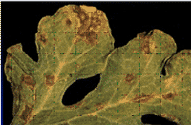
Figure 1.
Close-up of anthracnose lesions on a watermelon leaf (Purdue University
photo).
|
|
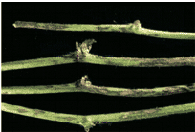
Figure 2.
Anthracnose lesions on watermelon stems.
|
The most noticeable symptoms appear on the fruit. Young fruits may
turn black, shrivel, and die if fruit pedicels are infected. Circular,
water-soaked spots develop on the older fruit. These lesions soon become
sharply sunken and then pinkish in moist weather, gradually turning
dark green to black with flesh-colored, oozing centers (Figures 3 and
4). The spots vary in size from 1/4 inch to 2½ inches in diameter,
depending on the kind of plant, age of the spot, extent of the lesions
and their tendency to merge.
Severely infected fruit are unsightly, insipid or bitter to the taste,
and rot quickly when secondary soft-rot organisms invade the broken
rind.
When the anthracnose fungus is seedborne the cotyledons droop and wilt,
and lesions may form on the stem near the soil line.\
Back to Top
|
|
Disease Cycle
The Colletotrichum fungus overwinters in refuse from a previous vine
crop (possibly up to 5 years) or in weeds of the cucurbit family. It may
be seedborne and is also transmitted by cucumber beetles. Frequent rains
accompanied by surface drainage water and temperatures around 75 F (23
C) favor the spread and buildup of the fungus. It may also be carried
by workers. The fungus can penetrate leaves directly and does not require
natural openings (e.g., stomates) or wounds. Initial infection requires
a period of 100 percent relative humidity for 24 hours and a temperature
of 68 to 75 F (20 to 23 C). Symptoms can appear within 6 days after infection
has taken place. Spore-bearing structures (acervuli) break through the
host surface (Figure 5) and produce tremendous numbers of one-celled,
colorless spores (conidia) which exude from the acervuli in moist weather.
The pinkish masses of conidia are formed on new lesions and serve as inoculum
for secondary disease cycles.
Most damage from anthracnose generally occurs late in the season after
the fruits are well formed. Post-harvest infections occur when fruit are
wounded and washed with contaminated water. Several distinct races of
the Colletotrichum fungus are known. Different kinds of host plants and
crop cultivars may react differently to these races.
|
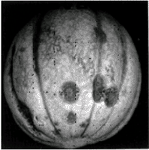
Figure 3.
Anthracnose lesions on a muskmelon fruit (Purdue University photo).
|
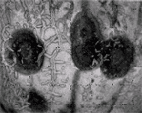
Figure 4.
Close-up of oozing anthracnose lesions on a muskmelon fruit (Purdue
University photo).
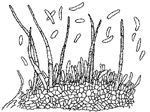
Figure 5.
Colletotrichum lagenarium, the anthracnose fungus. (Below) Section of
an acervulus showing short conidiophores, many bearing immature conidia,
and tall dark bristles (setae); (Above) one-celled colorless conidia
(drawing by L. Gray).
|
Control
1. Plant only certified, disease-free seed grown in a semiarid areas
in the western United States.
2. Rotate with crops other than cucurbits for 3 years or longer. Plant
in well-drained soil free from surface run-off water.
3. Avoid cultivating or handling plants when they are wet with dew or
rain.
4. Control all weeds, especially wild and volunteer cucurbits.
5. Where feasible, collect and burn or plow down cleanly all infected
plant debris after harvest.
6. Follow a rigorous, weekly spray program starting at the first true
leaf stage. Thorough coverage of all plant parts must be accomplished
if desired control is to be achieved. Try to time sprays just before rainy
periods when infections occur. Follow the manufacturer's directions regarding
amounts to use, the interval between the last spray and harvest, and compatibility
between fungicides and insecticides.
7. To prevent post-harvest losses avoid wounding (bruising, scratching,
or puncturing) fruits. Immersing fruits in clean and fresh wash water
containing 120 parts per million of chlorine aids in preventing new infections
but does not eradicate previous infections.
8. Where practical, grow watermelon and cucumber cultivars with resistance
to common races of the anthracnose fungus.
Updated information concerning weed control, spray schedule, and disease
control is available in the Midwest Vegetable Production Guide for Commercial
Growers, publication C-1364; and Illinois Homeowner's Guide to Pest Management,
publication C-1354 available at your nearest Extension Office.
|
Back to Top
|



